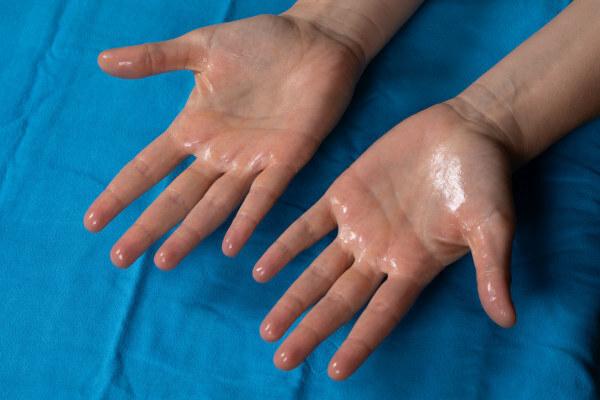Hyperhidrosis is characterized by an excessive production of sweat, overcoming our body's need to establish thermoregulation. It is common, on hot days or when we practice some physical activity, to produce a high amount of sweat, which is important to reduce our body temperature, leaving it within the proper standards.
In the case of hyperhidrosis, the individual produces excessive sweating even at rest, which can be very unpleasant and directly impact the quality of life of that person. It is not known for sure whether the highest incidence of hyperhidrosis is observed in men or women, however, women seek more care than men. It is estimated that hyperhidrosis affects 1% to 5% of the population.
Read more: Sweat gland - responsible for sweat production
What is hyperhidrosis?
Hyperhidrosis is a condition characterized by excessive sweating., which occurs due to hyperfunctioning sweat glands. People with this condition can sweat profusely even when they are not doing any physical activity. Various parts of the body can be affected, such as the armpits, the palms of the hands, the soles of the feet and the groin. In some people, sweating can be located in small areas, such as those mentioned, or it can occur in a generalized way, reaching several parts of the body at the same time.

cause of hyperhidrosis
Hyperhidrosis can present different causes. Some studies have shown that the condition can present Link genetics. Furthermore, its etiology may be secondary to other problems, such as metabolic disorders, neoplasms, neurological disorders, infections, anxiety, stress, and injuries in the spinal cordhuhThe.
Read too: Basic concepts in genetics
Hyperhidrosis symptoms
Hyperhidrosis is characterized by excessive production of sweat, which is its main symptom. Sweating can affect the whole body or be limited to some region, such as hands, feet or armpits.
Types of hyperhidrosis
According to the Brazilian Society of Dermatology (SBD), we can divide hyperhidrosis into two basic types: focal primary and generalized secondary.
- Primary focal hyperhidrosis: it appears in childhood or adolescence and affects areas such as the armpits, hands, feet, head or face. In primary focal hyperhidrosis, sweating does not occur while these people are at rest.
- Generalized secondary hyperhidrosis: it usually affects individuals in adulthood. It is characterized by causing sweating in various regions of the body or in unusual areas. It arises as a consequence of a health problem or even as a side effect of the use of any medication. Unlike focal primary, in generalized secondary hyperhidrosis, people also sweat during sleep.
Consequences of hyperhidrosis

Hyperhidrosis can be quite embarrassing for the individual who has it. It is very common for people with this condition to be ashamed of it, which can trigger problems such as anxiety and depression. Patients with hyperhidrosis often report, for example, avoiding handshakes and other situations that require contact because they have the skin wet often.
Although sweat does not have an unpleasant smell, hyperhidrosis can lead to bromhidrosis (condition in which sweat is accompanied by an unpleasant and strong odor). We must also mention that excessive sweating can favor the development of mycoseswhen it affects the feet region.
It is important to highlight, however, that hyperhidrosis is treatable, which can improve the quality of life of these individuals. However, information about the problem is limited, which makes many are unaware of adequate therapies to get around it.
Hyperhidrosis treatment
Hyperhidrosis is treatable. Many patients manage to solve the problem just using antiperspirants, others, however, make use of medicines and other procedures, which will be described below:
- Botulinum toxin: is applied in the region where sweating is occurring excessively, temporarily blocking it. The toxin works by blocking nerve stimuli to the sweat glands. The results of the technique last about six months.
- Curettage and liposuction: consists of scraping or liposuction of sweat glands and fat located in the armpit region, thus reducing the elimination of sweat.
- Endoscopic Thoracic Sympathectomy (STE): it is a technique used mainly in cases where the hands and feet are affected and the patient is not responding adequately to clinical treatments. It is a surgical procedure that works by “turning off” the signal that stimulates sweat production.
- Iontophoresis: in this procedure, electricity will be used to temporarily neutralize the sweat gland.
By Vanessa Sardinha dos Santos
Biology teacher

